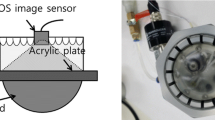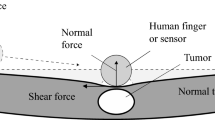Abstract
The collection of tactile information in minimally invasive surgery can give the surgeons important information about the tactile nature of the tissues being manipulated. In this paper, the dimensional design of a tactile sensor with an inverted V-shaped indenter is analyzed to distinguish the relative hardness and calculate the shear modulus of tissue. Contact analysis is performed between the tactile sensor and the elastic tissue according to the Barber’s method, in the case of a small ratio of the inner and outer contact radii, and Grinberg and Kuritsyn’s method in the case of a large ratio, respectively. Two analytical solutions are derived to show the relation of pressure, shear modulus and ratio. The demarcation point, 0.41 of ratio, is found which determines a choice of two load functions. The analytical solutions can be used to identify the relative hardness and calculate the shear modulus directly, which are verified in the experiments. Although the sensor size is big now, the measurement method for tissue identification is promising. The contact process is also capable to be used for analyzing the interaction between other medical equipment and elastic tissue.







Similar content being viewed by others
Explore related subjects
Discover the latest articles, news and stories from top researchers in related subjects.References
Bholat OS, Haluck RS, Murray WB, Gorman PJ, Krummel TM (1999) Tactile feedback is present during minimally invasive surgery 1. J Am Coll Surg 189(4):349–355
Shah J, Buckley D, Frisby J, Darzi A (2003) Depth cue reliance in surgeons and medical students. Surg Endosc Other Interv Techn 17(9):1472–1474
Schauer P, Ikramuddin S, Hamad G, Gourash W (2003) The learning curve for laparoscopic Roux-en-Y gastric bypass is 100 cases. Surg Endos Other Interv Tech 17(2):212–215
Tuantranont A, Lomas T, Bright V (2004) Micromachined piezoresistive tactile sensor array fabricated by bulk-etched MUMPs process. In: Proceedings of the NSTI nanotechnology conference, pp 351–354
Wisitsoraat A, Patthanasetakul V, Lomas T, Tuantranont A (2007) Low cost thin film based piezoresistive MEMS tactile sensor. Sens Actuators A 139(1):17–22
Lee C, Kim U, Lee D-H, Canh Toan N, Dat Tien N, Hoa P, Park J, Jung H, Choi HR (2017) Development of a smart handheld surgical tool with tactile feedback. Intel Serv Robot 10(2):149–158. https://doi.org/10.1007/s11370-016-0214-5
Li T, Shi C, Ren H (2018) A high-sensitivity tactile sensor array based on fiber Bragg grating sensing for tissue palpation in minimally invasive surgery. IEEE/ASME Trans Mechatron 23(5):2306–2315
Bandari NM, Ahmadi R, Hooshiar A, Dargahi J, Packirisamy M (2017) Hybrid piezoresistive-optical tactile sensor for simultaneous measurement of tissue stiffness and detection of tissue discontinuity in robot-assisted minimally invasive surgery. J Biomed Opt 22(7):077002
Zhang L, Ju F, Cao Y, Wang Y, Chen B (2017) A tactile sensor for measuring hardness of soft tissue with applications to minimally invasive surgery. Sens Actuators A 266:197–204
Beekmans S, Iannuzzi D (2016) Characterizing tissue stiffness at the tip of a rigid needle using an opto-mechanical force sensor. Biomed Microdevice 18(1):15
Ju F, Ling S-F (2015) A micro whisker transducer with sensorless mechanical impedance detection capability for fluid and tactile sensing in space-limited applications. Sens Actuators A 234:104–112
Åstrand AP, Jalkanen V, Andersson BM, Lindahl OA (2011) A flexible sensor system using resonance technology for soft tissue stiffness measurements—evaluation on silicone. In: 15th Nordic-Baltic conference on biomedical engineering and medical physics (NBC 2011). Springer, pp 21–24
Jalkanen V, Andersson BM, Lindahl O Stiffness of a small tissue phantom measured by a tactile resonance sensor. In: XII Mediterranean conference on medical and biological engineering and computing 2010, 2010. Springer, pp 395–398
Packirisamy M, Dargahi J, Sokhanvar S (2007) A multifunctional PVDF-based tactile sensor for minimally invasive surgery. Smart Mater Struct 16(16):989–998
Bonomo C, Brunetto P, Fortuna L, Giannone P, Graziani S, Strazzeri S (2008) A tactile sensor for biomedical applications based on IPMCs. IEEE Sens J 8(8):1486–1493
Kalantari M, Ramezanifard M, Ahmadi R, Dargahi J, Kövecses J (2011) A piezoresistive tactile sensor for tissue characterization during catheter-based cardiac surgery. Int J Med Robot Comput Assist Surg 7(4):431–440
Hoyt K, Castaneda B, Zhang M, Nigwekar P, di Sant’Agnese PA, Joseph JV, Strang J, Rubens DJ, Parker KJ (2008) Tissue elasticity properties as biomarkers for prostate cancer. Cancer Biomark 4(4–5):213–225
Wang FF, Shen JJ, Wu YY (2018) Passive tactile sensor for measuring elastic modulus of soft material: continuum-mechanics model and experiment. Sens Actuators A 283:291–297
Gubenko MM, Morozov AV, Lyubicheva AN, Goryacheva IG, Dosaev MZ, Ju MS, Yeh CH, Su FC (2017) Video-tactile pneumatic sensor for soft tissue elastic modulus estimation. Biomed Eng Online 16(1):94
Peng P, Rajamani R, Erdman AG (2009) Flexible tactile sensor for tissue elasticity measurements. J Microelectromech Syst 18(6):1226–1233
El Bab AMRF, Sugano K, Tsuchiya T, Tabata O, Eltaib MEH, Sallam MM (2012) Micromachined tactile sensor for soft-tissue compliance detection. J Microelectromech Syst 21(3):635–645. https://doi.org/10.1109/JMEMS.2012.2184080
Pailler-Mattei C, Bec S, Zahouani H (2008) In vivo measurements of the elastic mechanical properties of human skin by indentation tests. Med Eng Phys 30(5):599–606. https://doi.org/10.1016/j.medengphy.2007.06.011
Li C, Yan D, Shen J (2019) A convex tactile sensor for isotropic tissue elastic modulus estimation based on the plane contact model. IEEE Sens J 19(15):6251–6259. https://doi.org/10.1109/JSEN.2019.2910289
Fouly A, FathEl-Bab AM, Nasr MN, Abouelsoud A (2017) Modeling and experimental testing of three-tip configuration tactile sensor for compensating the error due to soft tissue surface irregularities during stiffness detection. Measurement 98:112–122
Barber JR (1980) Indentation of the semi-infinite elastic solid by a concave rigid punch. J Elast 6(2):421–427
Collins WD (1963) On the solution of some axisymmetric boundary value problems by means of integral equations: VIII. Potential problems for a circular annulus. Proc Edinb Math Soc 13(3):235–246. https://doi.org/10.1017/s0013091500010889
Grinberg GA, Kuricyn VN (1961) Diffraction of a plane electromagnetic wave on an ideally conducting flat ring and the electrostatic problem for such a ring. Zhurtekhfiz 31:1017–1025
Xie GJ (2009) Wireline Formation Tester PACKER rubber surface finite element analysis and optimization. Lanzhou University of Technology, Lanzhou
Lötters JC, Olthuis W, Veltink PH, Bergveld P (1999) The mechanical properties of the rubber elastic polymer polydimethylsiloxane for sensor applications. J Micromech Microeng 797(3):145–147
ETM series, A-type single colum microcomputer controlled electronic univeral testing machine. http://www.wance.com.cn/products/dzwnsyj/7b2be3f0-1e65-4005-bcd2-32d50126cef5.html
Delaine-Smith R, Burney S, Balkwill F, Knight M (2016) Experimental validation of a flat punch indentation methodology calibrated against unconfined compression tests for determination of soft tissue biomechanics. J Mech Behav Biomed Mater 60:401–415
Zhang M, Zheng Y, Mak AF (1997) Estimating the effective Young’s modulus of soft tissues from indentation tests—nonlinear finite element analysis of effects of friction and large deformation. Med Eng Phys 19(6):512–517
Acknowledgments
We would like to acknowledge Prof. Jason Moore and Dr. Pralav Shetty, Department of Mechanical and Nuclear Engineering, Pennsylvania State University, USA, for their help in English language and constructive advice of paper structure in this study.
Funding
This study was funded by the Natural Science Foundation of Jiangsu Province (Grant No. BK20141414).
Author information
Authors and Affiliations
Corresponding author
Ethics declarations
Conflict of interest
The authors declare that they have no conflict of interest.
Research involving human participants and/or animals
This article does not contain any studies with human participants or animals performed by any of the authors. This article does not contain patient data.
Informed consent
Informed consent was obtained from all individual participants included in the study. Additional informed consent was obtained from all individual participants for whom identifying information is included in this article.
Additional information
Publisher's Note
Springer Nature remains neutral with regard to jurisdictional claims in published maps and institutional affiliations.
Rights and permissions
About this article
Cite this article
Li, C., Lü, G. & Shen, J. Tactile sensor with an inverted V-shaped indenter for elastic tissue identification. Intel Serv Robotics 13, 113–121 (2020). https://doi.org/10.1007/s11370-019-00304-8
Received:
Accepted:
Published:
Issue Date:
DOI: https://doi.org/10.1007/s11370-019-00304-8




